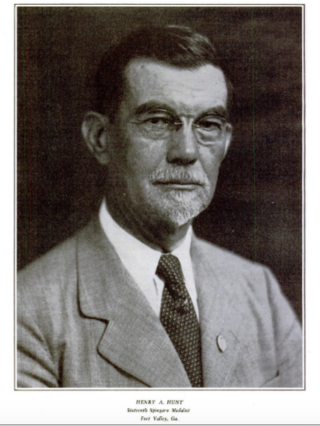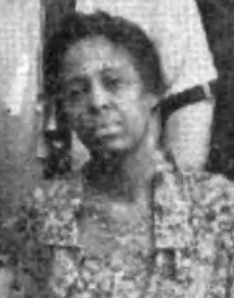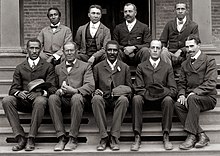
George Washington Carver was an American agricultural scientist and inventor who promoted alternative crops to cotton and methods to prevent soil depletion. He was one of the most prominent black scientists of the early 20th century.

Booker Taliaferro Washington was an American educator, author, orator, and adviser to several presidents of the United States. Between 1890 and 1915, Washington was the dominant leader in the African-American community and of the contemporary Black elite. Washington was from the last generation of black American leaders born into slavery and became the leading voice of the former slaves and their descendants. They were newly oppressed in the South by disenfranchisement and the Jim Crow discriminatory laws enacted in the post-Reconstruction Southern states in the late 19th and early 20th centuries.

Tuskegee University, formerly known as the Tuskegee Institute, is a private, historically black land-grant university in Tuskegee, Alabama. It was founded on Independence Day in 1881 by the state legislature.

Hampton University is a private, historically black, research university in Hampton, Virginia. Founded in 1868 as Hampton Agricultural and Industrial School, it was established by Black and White leaders of the American Missionary Association after the American Civil War to provide education to freedmen. The campus houses the Hampton University Museum, which is the oldest museum of the African diaspora in the United States and the oldest museum in the commonwealth of Virginia. First led by former Union General Samuel Chapman Armstrong, Hampton University's main campus is located on 314 acres in Hampton, Virginia, on the banks of the Hampton River.

Robert Russa Moton was an American educator and author. He served as an administrator at Hampton Institute. In 1915 he was named principal of Tuskegee Institute, after the death of founder Booker T. Washington, a position he held for 20 years until retirement in 1935.
The John F. Slater Fund for the Education of Freedmen was a financial endowment established in 1882 by John Fox Slater for education of African Americans in the Southern United States. It ceased independent operation in 1937, by which time it had disbursed about $4,000,000.
Negro Colleges in War Time is a short propaganda film produced by the Office of War Information in 1943. Other than in the title no reference is made to the students' race.

Thomas Monroe Campbell (1883–1956) was the first Cooperative Extension Agent in the United States and headed the first Extension Program as a field agent for the U.S. Department of Agriculture. Well known for his work under the tutelage of Booker T. Washington and peered with George Washington Carver, Campbell was also the winner of the Harmon Award in 1930 for his service in the field of agriculture. He authored of the book The Movable School Goes to the Negro Farmer. He was a nationally known and well respected public servant of the first rank. A bust of Campbell can be found in the Tuskegee University Library.

The George Washington Carver Museum is a museum located in Tuskegee, Alabama, United States. It is a part of the Tuskegee Institute National Historic Site. The museum, located on the campus of Tuskegee University, is managed by the US National Park Service, with self-guided tours.

Henry Alexander Hunt was an American educator who led efforts to reach blacks in rural areas of Georgia. He was awarded the Spingarn Medal by the National Association for the Advancement of Colored People (NAACP), as well as the Harmon Prize. In addition, he was recruited in the 1930s by President Franklin D. Roosevelt to join the president's Black Cabinet, an informal group of more than 40 prominent African Americans appointed to positions in the executive agencies.

Emmett Jay Scott was a journalist, founding newspaper editor, government official and envoy, educator, and author. He was Booker T. Washington's closest adviser at the Tuskegee Institute. He was responsible for maintaining Washington's nationwide "machine," with its close links to the black business leadership, white philanthropists, and Republican politicians from the local level to the White House. After Washington's death, Scott lost his Tuskegee connection, but moved to Washington, D.C. as Special Adviser of Black Affairs to Secretary of War Newton D. Baker. Scott was the highest-ranking African-American in President Woodrow Wilson's administration. After 1919, he was less and less visible in national affairs, with the NAACP taking the leadership role that Booker T. Washington had dominated.
Carver Junior College, in Cocoa, Florida, was established by the Brevard County Board of Public Instruction in 1960 to serve black students, at the same time that it founded Brevard Junior College, now Eastern Florida State College, for white students. It was named for the black agricultural researcher George Washington Carver. Like 10 of Florida's other 11 black junior colleges, it was founded as a result of a 1957 decision by the Florida Legislature to preserve racial segregation in education, mandated under the 1885 Constitution that was in effect until 1968. More specifically, the Legislature wanted to show, in response to the unanimous Supreme Court decision mandating school integration, that the older standard of "separate but equal" educational facilities was still viable in Florida. Prior to this legislative initiative, the only publicly funded colleges for negro or colored students were Florida A&M University, in Tallahassee, and Booker T. Washington Junior College, in Pensacola.

Bess Bolden Walcott (1886-1988) was an American educator, librarian, museum curator and activist who helped establish the historical significance of the Tuskegee University. Recruited by Booker T. Washington to help him coordinate his library and teach science, she remained at the institute until 1962, but continued her service into the 1970s. Throughout her fifty-four year career at Tuskegee, she organized Washington's library, taught science and English at the institute, served as founder and editor of two of the major campus publications, directed public relations, established the Red Cross chapter, curated the George Washington Carver collection and museum and assisted in Tuskegee being placed on the National Register of Historic Places.

Jennie B. Moton (1879-1942) was an American educator and clubwoman. As a special field agent for the Agricultural Adjustment Administration (AAA) in the 1930s and 40s, she worked to improve the lives of rural African Americans in the South. She directed the department of Women's Industries at the Tuskegee Institute, presided over the Tuskegee Woman's Club, and was a two-term president of the National Association of Colored Women (NACW).
Claude Albert Barnett was an American journalist, publisher, entrepreneur, philanthropist, civic activist, Pan-Africanist, and founder of the Associated Negro Press (ANP). He started the first international news agency for black newspapers. He was an advocate against segregation in the military and blood supply. He was an activist force in journalism. He promoted Pan-Africanism. The (ANP) documented the Civil Rights Movement in the United States of America, and struggles for independence in Africa. Associated Negro Press was a Pan-African news service. Claude Barnett, Robert S. Abbott, and John H. Johnson were three of the most influential African-American media entrepreneurs in the 20th century. They were based in Chicago, Illinois. Barnett is said to have advanced the role of the Black Press in press coverage, news sharing, advertising, public relations, and professionalism.

William Henry Holtzclaw (1870–1943) was an educator and the founder of Utica Institute in Mississippi. Holtzclaw was a graduate of the Tuskegee Institute and desired to start his own school. He settled in Utica, Mississippi, bought land on credit, and persuaded the locals to appoint him teacher of what was then called the Utica Negro School in 1902. Holtzclaw and his students built the first and second school buildings themselves. By 1903 the school had 225 pupils and was supported by white and black members of the community. The school became incorporated by the state of Mississippi as the Utica Normal and Industrial Institute for the Training of Colored Young Men and Women and taught both academic subjects and also vocational work. Holtzclaw became principal of the school and worked on attracting funds, and received donations from Andrew Carnegie.
James Nathan Calloway was an American agriculturalist. Born in slavery in Tennessee, Calloway graduated from Fisk University before joining the faculty of the Tuskegee Institute. Initially a lecturer in mathematics, he became involved in agricultural science and was appointed manager of the institute's largest farm in 1897. He was selected to lead an expedition to German Togoland in 1900 to promote the production of cotton there. Calloway bred a special strain of the plant suited to local conditions but returned to the United States a year later. The experimental station that he founded remained in use until 1919 and established cotton as a staple crop of the colony. He returned to Tuskegee as farm manager and taught agriculture there until at least 1930.
Oakland Normal School was a normal school in Oakland, Colorado County, Texas for training African American teachers. The school opened in 1882 and operated for over three decades. G. R. Townsend and then Robert Lloyd Smith served as the school's principals.

Alice Carter Simmons was an American pianist, organist, and music educator. She was the founding secretary of the National Association of Negro Musicians (NANM), and was head of the instrumental music program at Tuskegee Institute beginning in 1916; she also taught at Fisk University.
Albon L. Holsey was a businessman and advocate for African American businesses. He served as executive secretary of the National Negro Business League. He received a William E. Harmon Foundation Award for Distinguished Achievement Among Negroes.













